Trees Birds Mammals Fish Amphibians Reptiles
Wild Algarve
Bookshop
Albatrellus ovinus (Schaeff.) Murrill - Forest Lamb
Phylum: Basidiomycota - Class: Agaricomycetes - Order: Russulales - Family: Albatrellaceae
Distribution - Taxonomic History - Etymology - Identification - Culinary Notes - Reference Sources
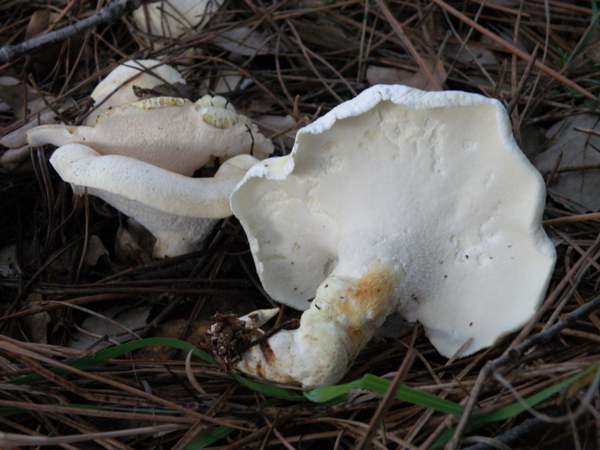
Seen from above these creamy white or grey-brown polypores, not known to be in Britain but common in some European countries, could be mistaken for Wood Hedgehogs, Hydnum repandum. Often, however, the caps are so distorted that they look more like crumpled paper bags. In the past this unusual mushroom was referred to as the Sheep Polypore or Pied de Mouton (Sheep's Foot); continuing the tradition its new English name is Forest Lamb. A shepherd with very poor eyesight might possibly mistake them for sheep a long way off.
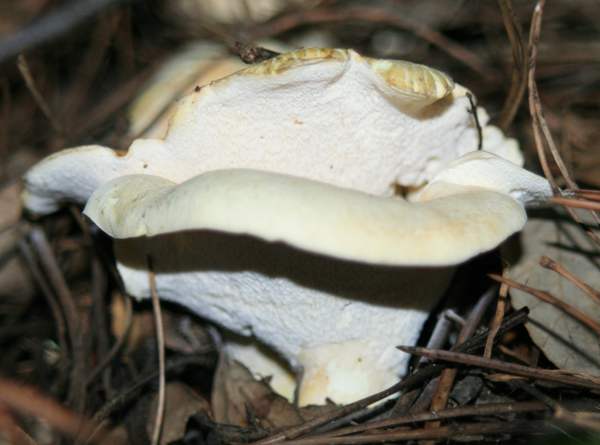
Distribution
A fairly common find many parts of mainland Europe, from Finland down to the Mediterranean, Albatrellus ovinus has not been officially recorded in either Britain or Ireland (although it has been given an English name in the BMS list of recommended common names of fungi).
Above: Often these large and conspicuous polypores appear in densely-packed groups.
Taxonomic history
In 1762, when Jacob Christian Schaeffer described this unusual polypore, he gave it the scientific binomial name Boletus ovinus, which establishes its basionym. It was an American mycologist, William Alphonso Murrill (1869 - 1957), who in 1903 transferred this species to its current genus, whereupon its currently-accepted scientific name Albatrellus ovinus was established.
Synonyms of Albatrellus ovinus include Boletus ovinus Schaeff., Boletus albidus Pers., Albatrellus albidus (Pers.) Gray, and Scutiger ovinus Murrill.
Etymology
Albatrellus, the genus name, is not so easy to see through, and I am grateful to Philip Rogosky for what follows: S F Gray explicitly attributes his Albatrellus to Pier Antonio Micheli's Albatrello. The first two vernacular names Micheli reports reference the strawberry tree Arbutus unedo - in Italian "corbezzolo", which in Micheli's region/dialect was (and still is) know as "albatro"/"arbatro", so they're a record of common associative names for the mushroom: the "strawberry tree mushroom". (He actually specifies that it also appears in chestnut groves.) However: Micheli actually intended another mushroom entirely: he was describing either the birch bolete / scaber stalk Leccinum scabrum or more likely perhaps Leccinellum pseudoscabrum, or even Leccinum aurantiacum. So... Gray picked up Micheli's strawberry-tree nomer, and stuck it onto the "fir plantation"-loving Forest Lamb/Sheep's Foot, unaware that it actually originally meant another associated tree altogether - and another mushroom!
The specific epithet ovinus is easy. It comes from the - Classical Latin noun ovis, meaning a sheep. (The old common name Sheep Polypore seems an apt reflection of this simile.)
Identification guide
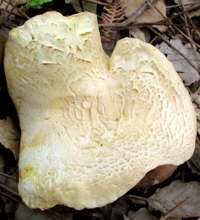 |
Cap
7 to 18cm across, irregular, creamy white or pale grey; convex, soon flattening and becoming centrally depressed, distorted and lobed; margin wavy and usually remaining incurved; skin cracks when old or in very dry weather. Often several caps merge and become firmly conjoined.
Stem
Creamy white or light grey; 3 to 7cm tall, 1 to 3cm diameter. |
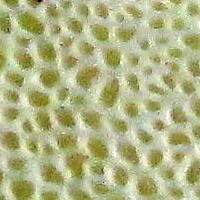 |
Pores
White or creamy yellow; mostly oval; tubes decurrent; spaced at 2 to 4 per mm. |
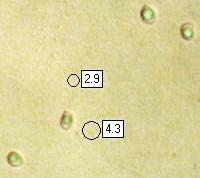 |
Spores
Ellipsoidal to subglobose, smooth, 4-4.5 x 3-3.5μm, with a germ pore; inamyloid
Spore print
White. |
Odour/taste |
Not significant. |
Habitat & Ecological role |
In woods, often under pines and other conifers. Some mycologists believe that this edible mushroom may be ectomycorrhizal with spruces. |
Season |
July to November in central Europe but into January or even February in southern Portugal and Mediterranean coastal areas. |
Similar species |
Albatrellus subrubescens is usually violet tinged on the cap surface, and it turns orange when bruised. Confident differentiation of these two very similar species requires microscopic examination of the spores, which are amyloid in Albatrellus subrufescens but inamyloid in Albatrellus ovinus. |
Culinary Notes
This is one of the very few polypores with a tradition of culinary popularity... if you happen to live in Finland, that is, for there it is sold commercially in large quantities. Elsewhere the local field guides seem for the most part to offer a vague 'generally considered edible' but without advice of recipes. Despite having numerous opportunities to gather these chunky woodland fungi on mainland Europe, we have not yet tried them and so we are unable to comment from first-hand experience. In texture they are very similar to Hydnum repandum, the Wood Hedgehog, which we find delicious in all sorts of dishes from soups and risottos to our own favourite invention which we call 'Hedgehogs on Toast'.
Reference Sources
Fascinated by Fungi, 2nd Edition, Pat O'Reilly 2016, reprinted by Coch-y-bonddu Books in 2022.
BMS List of English Names for Fungi
Dictionary of the Fungi; Paul M. Kirk, Paul F. Cannon, David W. Minter and J. A. Stalpers; CABI, 2008
Taxonomic history and synonym information on these pages is drawn from many sources but in particular from the British Mycological Society's GB Checklist of Fungi.
Top of page...
Fascinated by Fungi. Back by popular demand, Pat O'Reilly's best-selling 450-page hardback book is available now. The latest second edition was republished with a sparkling new cover design in September 2022 by Coch-y-Bonddu Books. Full details and copies are available from the publisher's online bookshop...